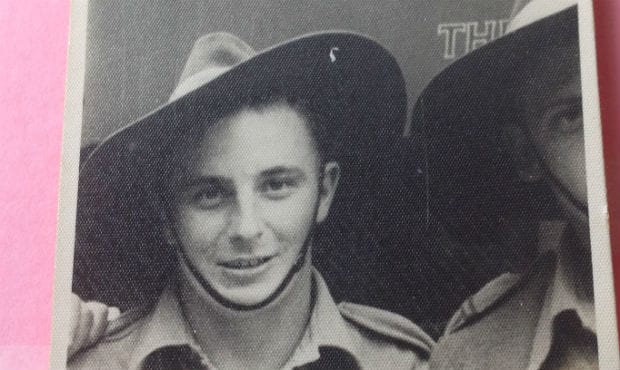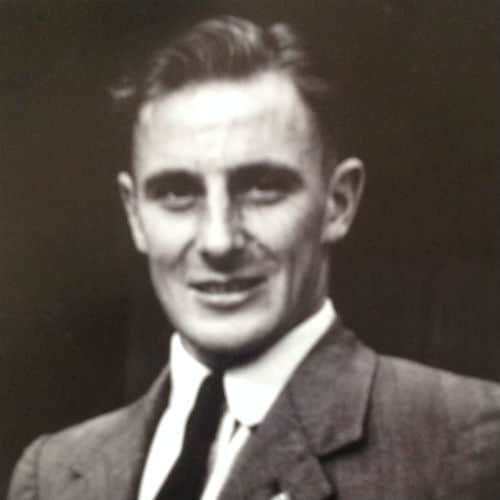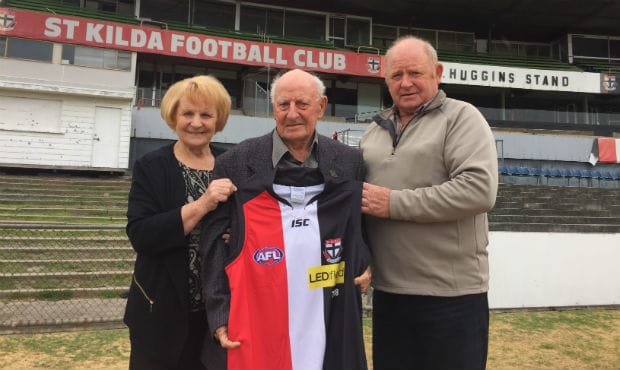Just 11,000 fans watched the Saints lose to the Demons that Saturday afternoon, but it was an experience the now 93 year-old will never forget.
“The first kick I got I kicked it into the fella that was on the mark,” Dawson says with a wry smile.
“At half-time my cousin was leaning over the fence and he sang out. I went over and he introduced me to half of the ground. I looked around and the rest of the players had gone off the ground, and there I was standing there talking to people in the crowd.”
Dawson is less than a month short of his 94th birthday. He’s come to Moorabbin from Tongala flanked by his daughter Kaye and eldest son Peter. Both are immensely proud of their father.
He is believed to be St Kilda’s oldest living player. Born in January 1921, he’s lived a rich and fulfilled life with family and football the driving forces.
He’s a bit slower than he used to be, but nevertheless still happy to reflect on his career and his life. It is a privilege to hear his story and it is a privilege for his family to hear him tell it.
This is no more evident than when Peter gets tears in his eyes listening to his elderly father recall his playing days.
Dawson played three games for St Kilda, and would have played many more had World War II not intervened.

Dawson, aged 20, just after he signed up to the Australian Army.
A skilful, quick and superbly fit rover/wingman who was renowned for his blind turn, he began playing seniors with Elmore at the age of 16 before arriving at the Junction Oval as a 19-year-old in late 1940.
It was 1925 Brownlow Medallist and St Kilda Hall of Fame member Col Watson who recommended Dawson to the Saints hierarchy after watching him play a game in the Bendigo Football League.
“I was playing for Rochester at the time. It was quite an experience for me, because to be a league footballer is something out of this world. I went down to Melbourne with a lot of expectations,” Dawson said.
“I had four shillings to my name. I walked to South Melbourne and started work at an International Harvesters place, dealing with trucks and tractors and all of that.”
Training was uncompromising and Jack ‘Cracker’ Knight ran a tight ship as the senior coach.
“It was high speed, intense circle work.”
“We just got the ball and kicked it as far as we could. Then we would chase after it and do it again… It took me a while to get up to speed when I first went down to training, but I eventually got the speed of the game.”
Bob doesn’t have 100 per cent recall of every story he tells and Peter and Kaye occasionally had to prompt their father, reminding him of key facts and details that had become muddled with the passing of time.
But when asked about his time in the Australian army, his mind was as sharp as ever.
“It wasn’t a difficult decision to join up. My father was in World War I,” he said.
“I travelled up to Alice Springs. In the last 12 months I went to Borneo. I didn’t play footy for four years.”

In 1946, as captain-coach of the Bloods, he won the league best and fairest with 31 votes, 20 votes ahead of second place.
After two seasons at Elmore, he returned to Tongala – a town with a population of 2000 in between Kyabram and Echuca, continuing his domination of country football as captain-coach while working at the Nestle factory.
He became an instant hero, leading his team to an unlikely premiership win over arch rival and neighbour Kyabram at Tatura.
In 1959 at the age of 38, Dawson retired, but coached the Tongala Under 17s for a further 18 seasons.
“I was a strict coach,” he recalls proudly.
“Hard work was important and my players followed this. No mucking around at training and it was a case of go home if you’re not interested.”

Once, Dawson even played on a young Tom Hafey. Folklore or not, he has no shame in claiming he had the better of the supremely fit Hafey.
“He couldn’t keep up,” Dawson said.
“I used to tell him he’s not getting a kick on me!”
A talented all-round sportsman, Dawson was right footed but handballed with his left hand.
This ambidexterity flowed into lawn bowls, a sport which he successfully played for decades after football.
Even a stroke in the late 1970s couldn’t limit Dawson, who was from then on limited on his right side. Determined to keep playing, he began bowling left-handed and is now a life member of Tongala Bowls Club.
While he rarely attends Saints games anymore, Dawson fondly names Robert Harvey as his favourite St Kilda player of all time, just in front of Lenny Hayes.
“I loved watching Robert Harvey for his toughness,” he said.
“I liked him because it was a case of ‘look out here I come’.”
From left to right: Peter (10), Bob (37) and Robert (8) in their Tongala Football Club jumpers, 1958.
In an age where the resources and commitment required of professional sport are consistently growing, Dawson said there was not much difference between country football and VFL football when he played.
“Playing in the country and in Melbourne was much the same in terms of standard. We just used to get the ball and kick it as far as we could,” he said.
“Now it is a different game altogether. Now they get the ball and kick it backwards. You have to go forwards as far as I’m concerned.”
Whatever his views on the modern game, Dawson tells a remarkable story. He’s seen plenty and is now a happily retired dairy farmer living a quiet life in country Victoria.
He has fair claim to being one of the greatest country footballers to pull on a jumper and certainly one of the most respected and revered.
As far as the club is aware, Dawson is one of three former Saints aged 90 or over.
Les Gardner (September 30, 1923) is almost three years his junior, while John Curtin (November 8, 1924) turned 90 last month.
Gardner played the first three matches of the 1947 season, while Curtin was selected for rounds one and two but never played for the Saints again.
Dawson was the 788th Saint to play for the club and was presented with his guernsey last month.

Bob Dawson, with his daughter Kaye and oldest son Peter by his side at Moorabbin.


